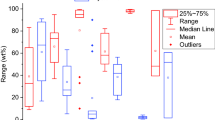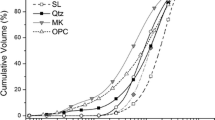Abstract
Recently, there has been a push for the development of new reactivity tests as an increasing range of materials try to fill the demand for supplementary cementitious materials (SCMs) in the concrete industry. RILEM Technical Committee 267-TRM evaluated current standardized and emerging methods for measuring SCM reactivity. The RILEM committee determined that a new reactivity test, the rapid, relevant, and reliable (R3) test, was reproducible across different laboratories, and results compared well with mortar compressive strength testing at 28 days for pozzolanic and latent hydraulic materials, but they did not consider the ability of the test to predict other properties, particularly those related to long-term durability. In this study, material classifications obtained from the R3 tests were compared to material performance in compressive strength, alkali-silica reactivity, sulfate resistance, and chloride penetrability testing. R3 classifications were effective at classifying compressive strength performance of mortar as well as chloride penetrability of concrete. Rapid reactivity tests can be used as a tool to predict material performance in concrete and help inform material choices before proceeding with more extensive performance testing.








Similar content being viewed by others
Notes
Testing performed at the Texas Department of Transportation (TxDOT).
References
Juenger MCG, Snellings R, Bernal SA (2019) Supplementary cementitious materials: new sources, characterization, and performance insights. Cem Concr Res 122:257–273. https://doi.org/10.1016/j.cemconres.2019.05.008
ASTM C1709 (2018) Standard Guide for Evaluation of Alternative Supplementary Cementitious Materials (ASCM) for Use in Concrete. ASTM International, West Conshohocken, PA
Kalina RD, Al-Shmaisani S, Ferron RD, Juenger MCG (2019) False positives in ASTM C618 specifications for natural Pozzolans. ACI Mater J 116:1–8. https://doi.org/10.14359/51712243
Seraj S, Juenger MCG (2016) Evaluation of an accelerated characterization method for Pozzolanic reactivity. Nov Charact Tech Adv Cem Mater Tribut to James J Beaudoin 1(1–1):16. https://doi.org/10.14359/51689364
Al-Shmaisani S, Kalina RD, Ferron RD, Juenger MCG (2022) Critical assessment of rapid methods to qualify supplementary cementitious materials for use in concrete. Cem Concr Res 153:106709. https://doi.org/10.1016/j.cemconres.2021.106709
Jang JK, Kalina RD, Al-Shmaisani S et al (2022) Assessing Pozzolanicity of supplementary cementitious materials using ASTM standard test methods. Adv Civ Eng Mater 11:20210149. https://doi.org/10.1520/ACEM20210149
Li X, Snellings R, Antoni M et al (2018) Reactivity tests for supplementary cementitious materials: RILEM TC 267-TRM phase 1. Mater Struct 51:151. https://doi.org/10.1617/s11527-018-1269-x
Lothenbach B, Durdziński P, De Weerdt K (2016) Thermogravimetric analysis. In: Scrivener K, Snellings R, Lothenbach B (eds) A practical guide to microstructural analysis of cementitious materials. Taylor and Francis Group, pp 177–211
Snellings R, Scrivener KL (2016) Rapid screening tests for supplementary cementitious materials: past and future. Mater Struct 49:3265–3279. https://doi.org/10.1617/s11527-015-0718-z
NF P 18-513 Annexe A (2010) Détermination de la quantité d’hydroxyde de calcium fixé (essai Chapelle modifié)
EN 196-5 (2011) Method of testing cement - Part 5: Pozzolanicity test for pozzolanic cement. European Committee for Standardization, Brussels, Belgium
IS 1727-1967 (2004) Methods of test for Pozzolanic materials. Bureau of Indian Standards, New Delhi, India
Parashar A, Vollpracht A, Haufe J et al (2022) Report of RILEM TC 267—TRM: Improvement and robustness study of lime mortar strength test for assessing reactivity of SCMs. Mater Struct 55:96. https://doi.org/10.1617/s11527-022-01911-1
Kasaniya M, Thomas MDA, Moffatt EG (2019) Development of rapid and reliable Pozzolanic reactivity test method. ACI Mater J 116:145–154. https://doi.org/10.14359/51716718
Avet F, Snellings R, Alujas Diaz A et al (2016) Development of a new rapid, relevant and reliable (R3) test method to evaluate the pozzolanic reactivity of calcined kaolinitic clays. Cem Concr Res 85:1–11. https://doi.org/10.1016/j.cemconres.2016.02.015
ASTM C1897 (2020) Standard Test Methods for Measuring the Reactivity of Supplementary Cementitious Materials by Isothermal Calorimetry and Bound Water Measurements. ASTM International, West Conshohocken, PA
Ali HA, Xuan D, Poon CS (2020) Assessment of long-term reactivity of initially lowly-reactive solid wastes as supplementary cementitious materials (SCMs). Constr Build Mater. https://doi.org/10.1016/j.conbuildmat.2019.117192
Parashar A, Bishnoi S (2020) A comparison of test methods to assess the strength potential of plain and blended supplementary cementitious materials. Constr Build Mater. https://doi.org/10.1016/j.conbuildmat.2020.119292
Kasaniya M, Alaibani A, Thomas MDA, Riding KA (2022) Exploring the efficacy of emerging reactivity tests in screening pozzolanic materials. Constr Build Mater 325:126781. https://doi.org/10.1016/j.conbuildmat.2022.126781
Suraneni P, Weiss J (2017) Examining the pozzolanicity of supplementary cementitious materials using isothermal calorimetry and thermogravimetric analysis. Cem Concr Compos 83:273–278. https://doi.org/10.1016/j.cemconcomp.2017.07.009
Zajac M, Rossberg A, Le Saout G, Lothenbach B (2014) Influence of limestone and anhydrite on the hydration of Portland cements. Cem Concr Compos 46:99–108. https://doi.org/10.1016/j.cemconcomp.2013.11.007
Suraneni P, Hajibabaee A, Ramanathan S et al (2019) New insights from reactivity testing of supplementary cementitious materials. Cem Concr Compos 103:331–338. https://doi.org/10.1016/j.cemconcomp.2019.05.017
Shakouri M, Exstrom CL, Ramanathan S et al (2020) Pretreatment of corn stover ash to improve its effectiveness as a supplementary cementitious material in concrete. Cem Concr Compos. https://doi.org/10.1016/j.cemconcomp.2020.103658
Ramanathan S, Kasaniya M, Tuen M et al (2020) Linking reactivity test outputs to properties of cementitious pastes made with supplementary cementitious materials. Cem Concr Compos. https://doi.org/10.1016/j.cemconcomp.2020.103742
Wang Y, Suraneni P (2019) Experimental methods to determine the feasibility of steel slags as supplementary cementitious materials. Constr Build Mater 204:458–467. https://doi.org/10.1016/j.conbuildmat.2019.01.196
Rajabipour F, Giannini E, Dunant C et al (2015) Alkali-silica reaction: current understanding of the reaction mechanisms and the knowledge gaps. Cem Concr Res 76:130–146. https://doi.org/10.1016/j.cemconres.2015.05.024
Thomas M (2011) The effect of supplementary cementing materials on alkali-silica reaction: a review. Cem Concr Res 41:1224–1231. https://doi.org/10.1016/j.cemconres.2010.11.003
Thomas M (2013) Supplementary cementing materials in concrete. Taylor and Francis Group
Al-Shmaisani S, Kalina RD, Douglas Ferron R, Juenger MCG (2022) Assessment of blended coal source fly ashes and blended fly ashes. Constr Build Mater 342:127918. https://doi.org/10.1016/j.conbuildmat.2022.127918
Kalina RD, Al-Shmaisani S, Seraj S et al (2021) Role of alkalis in natural pozzolans on alkali-silica reaction. ACI Mater J 118:83–89. https://doi.org/10.14359/51732598
ASTM C109/C109M (2020) Standard test method for compressive strength of hydraulic cement mortars (Using 2-in. or [50 mm] Cube Specimens). ASTM International, West Conshohocken, PA
ASTM C39/C39M (2020) Standard test method for compressive strength of cylindrical concrete specimens. ASTM International, West Conshohocken, PA
ASTM C1567 (2013) Standard test method for determining the potential alkali-silica reactivity of combinations of cementitious materials and aggregate (Accelerated Mortar-Bar Method). ASTM International, West Conshohocken, PA
ASTM C1293 (2020) Standard test method for determination of length change of concrete due to alkali-silica reaction. ASTM International, West Conshohocken, PA
ASTM C1012/C1012M (2018) Standard test method for length change of hydraulic-cement mortars exposed to a sulfate solution. ASTM International, West Conshohocken, PA
ASTM C1202 (2019) Standard test method for electrical indication of concrete’s ability to resist chloride ion penetration. ASTM International, West Conshohocken, PA
EN 450-1 (2012) Fly ash for concrete - Part 1: Definition, specifications and conformity criteria. European Committee for Standardization, Brussels, Belgium
Londono-Zuluaga D, Gholizadeh-Vayghan A, Winnefeld F et al (2022) Report of RILEM TC 267-TRM phase 3: validation of the R3 reactivity test across a wide range of materials. Mater Struct 55:142. https://doi.org/10.1617/s11527-022-01947-3
Lothenbach B, Zajac M (2019) Application of thermodynamic modelling to hydrated cements. Cem Concr Res. https://doi.org/10.1016/j.cemconres.2019.105779
ACI Committee 201 (2016) Guide to Durable Concrete (ACI 201.2R-16). Farmington Hills, MI
Avet F, Scrivener K (2018) Investigation of the calcined kaolinite content on the hydration of limestone calcined clay cement (LC3). Cem Concr Res 107:124–135. https://doi.org/10.1016/j.cemconres.2018.02.016
Adu-Amankwah S, Black L, Skocek J et al (2018) Effect of sulfate additions on hydration and performance of ternary slag-limestone composite cements. Constr Build Mater 164:451–462. https://doi.org/10.1016/j.conbuildmat.2017.12.165
Lothenbach B, Scrivener K, Hooton RD (2011) Supplementary cementitious materials. Cem Concr Res 41:1244–1256. https://doi.org/10.1016/j.cemconres.2010.12.001
Wadsö L, Winnefeld F, Riding K, Sandberg P (2016) Calorimetry. In: Scrivener K, Snellings R, Lothenbach B (eds) A practical guide to microstructural analysis of cementitious materials. Taylor and Francis Group, pp 37–74
Skibsted J, Snellings R (2019) Reactivity of supplementary cementitious materials (SCMs) in cement blends. Cem Concr Res 124:105799. https://doi.org/10.1016/j.cemconres.2019.105799
Berodier E, Scrivener K (2015) Evolution of pore structure in blended systems. Cem Concr Res 73:25–35. https://doi.org/10.1016/j.cemconres.2015.02.025
De Belie N, Soutsos M, Gruyaert E (eds) (2018) Properties of Fresh and Hardened Concrete Containing Supplementary Cementitious Materials: State-of-the-Art Report of the RILEM Technical Committee 238-SCM, Working Group 4. (RILEM State-of-the-Art Reports; Vol. 25). Springer International Publishing
Kaplan MF (1959) Flexural and compressive strength of concrete as affected by the properties of coarse aggregates. ACI J Proc. https://doi.org/10.14359/11415
Scrivener KL, Crumbie AK, Laugesen P (2004) The interfacial transition zone (ITZ) between cement paste and aggregate in concrete. Interface Sci 12:411–421. https://doi.org/10.1023/B:INTS.0000042339.92990.4c
Weaver WS, Isabelle HL, Williamson F (1974) A study of cement and concrete correlation. J Test Eval 2:260–303. https://doi.org/10.1520/JTE10110J
Thomas MDA, Folliard KJ (2007) Concrete aggregates and the durability of concrete. In: Page CL, Page MM (eds) Durability of concrete and cement composites. Woodhead Publishing, pp 247–281
Deschenes R, Jones C, Giannini ER, Hale M (2019) A modified chemical index to predict fly ash dosage for mitigating alkali-silica reaction. Adv Civ Eng Mater 8:699–722. https://doi.org/10.1520/ACEM20190191
Gholizadeh Vayghan A, Wright JR, Rajabipour F (2016) An extended chemical index model to predict the fly ash dosage necessary for mitigating alkali-silica reaction in concrete. Cem Concr Res 82:1–10. https://doi.org/10.1016/j.cemconres.2015.12.014
Ideker JH, Bentivegna AF, Folliard KJ, Juenger MCG (2012) Do current laboratory test methods accurately predict alkali-silica reactivity? ACI Mater J 109:395–402. https://doi.org/10.14359/51683914
Tanesi J, Drimalas T, Chopperla KST et al (2020) Divergence between performance in the field and laboratory test results for alkali-silica reaction. Transp Res Rec 2674:120–134. https://doi.org/10.1177/0361198120913288
Shi Z, Ferreiro S, Lothenbach B et al (2019) Sulfate resistance of calcined clay – Limestone – Portland cements. Cem Concr Res 116:238–251. https://doi.org/10.1016/j.cemconres.2018.11.003
Dhole R, Thomas MDA, Folliard KJ, Drimalas T (2013) Characterization of fly ashes for sulfate resistance. ACI Mater J 110:159–168. https://doi.org/10.14359/51685530
Layssi H, Ghods P, Alizadeh AR, Salehi M (2015) Electrical resistivity of concrete: concepts, applications, and measurement techniques. Concr Int 37(5):41–46
Spragg R, Villani C, Snyder K et al (2013) Factors that influence electrical resistivity measurements in cementitious systems. Transp Res Rec 11:90–98. https://doi.org/10.3141/2342-11
Acknowledgements
The authors wish to thank the Texas Department of Transportation (TxDOT) under Project 0-6966 for providing funding for the work. Katelyn O’Quinn, Jae Jang, Mike Rung, and Masoud Moradian, are thanked for assistance with data collection. The authors also thank Prannoy Suraneni, Sivakumar Ramanathan, Kevin Folliard, and Thanos Drimalas for their helpful discussions and insight regarding these topics, and the various suppliers of the materials used in this study.
Author information
Authors and Affiliations
Contributions
SA: Conceptualization, Methodology, Validation, Formal Analysis, Investigation, Writing—Original Draft, Visualization; RDK: Validation, Investigation, Writing—Review and Editing; RDF: Writing—Review and Editing; MCGJ: Conceptualization, Methodology, Writing—Review and Editing, Supervision, Project Administration, Funding Acquisition.
Corresponding author
Ethics declarations
Conflict of interest
The authors declare that they have no conflict of interest.
Additional information
Publisher's Note
Springer Nature remains neutral with regard to jurisdictional claims in published maps and institutional affiliations.
Supplementary Information
Below is the link to the electronic supplementary material.
Rights and permissions
About this article
Cite this article
Al-Shmaisani, S., Kalina, R.D., Ferron, R.D. et al. Comparison of SCM reactivity to performance in cement-based mixtures. Mater Struct 55, 241 (2022). https://doi.org/10.1617/s11527-022-02072-x
Received:
Accepted:
Published:
DOI: https://doi.org/10.1617/s11527-022-02072-x




